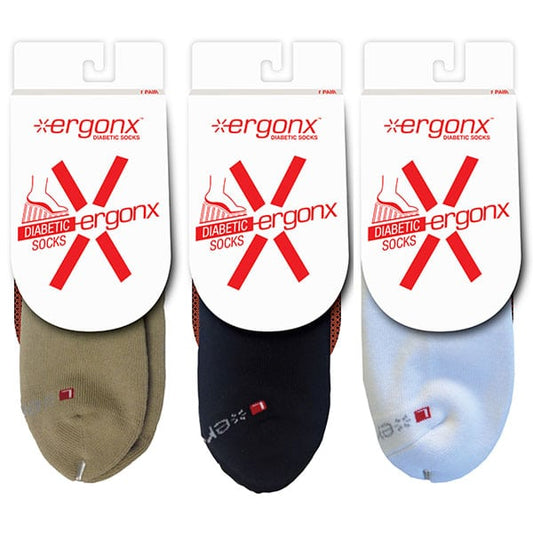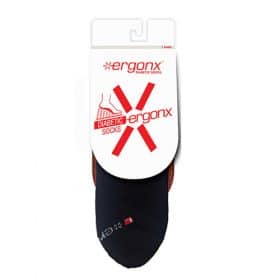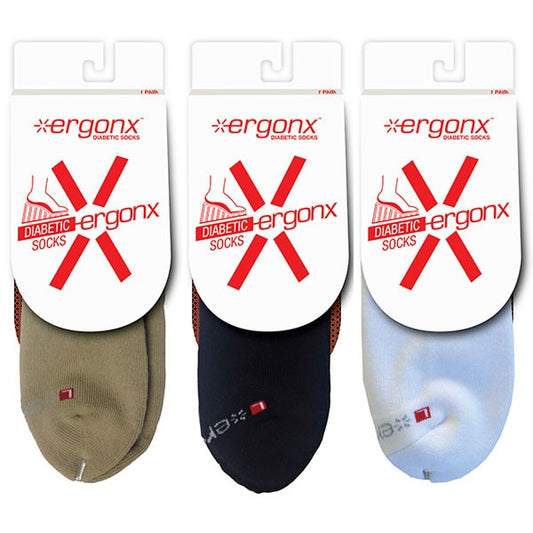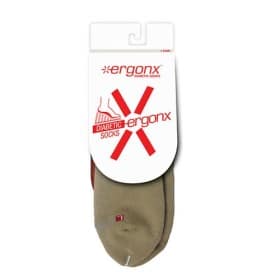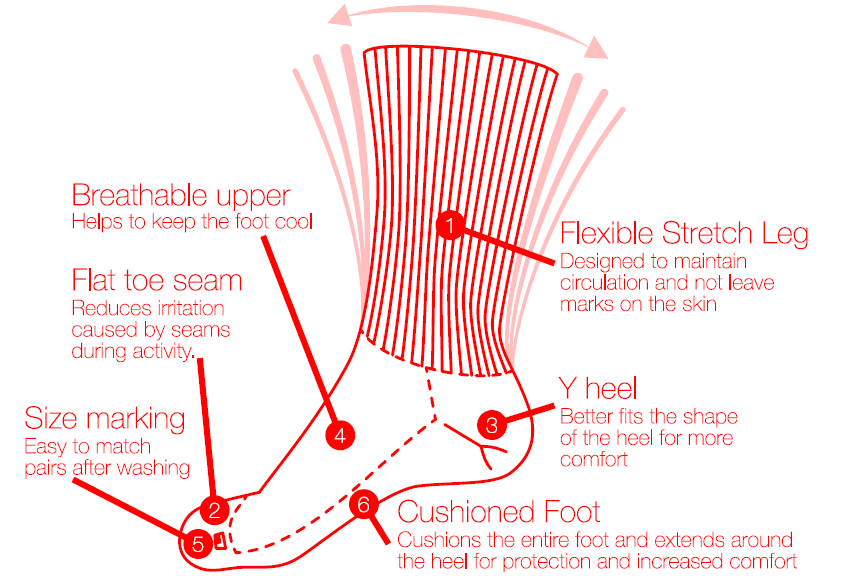Our entire range has been crafted over the last 15 years by Australian Podiatrists within the Australian market. Each product has been tried, tested and improved so you can trust you are getting the very best for your feet.
Choose from our most popular orthotics, footwear, work boots, socks and more below:
-
Ergonx Diabetic Socks Crew (6 Pack)
Regular price $149.70 AUDRegular priceUnit price per -
Ergonx Diabetic Socks 1/4 Crew (6 Pack)
Regular price $149.70 AUDRegular priceUnit price per
Podiatrist Review
WHAT ARE THE BEST SOCKS FOR DIABETICS?
When we are treating diabetic patients in the podiatry clinic, the main aim of our treatment is to avoid the complications of diabetes. One of the major complications we see is infection and amputation.
Diabetic patients are more “at risk” of infection and amputation because diabetes damages the nerves (diabetic neuropathy) and blood vessels in their feet. This makes the feet more susceptible to injury (they can’t feel the injury) and less likely to heal quickly (the blood flow is compromised). This makes the diabetic foot more likely to suffer from infection and amputation.
Part of our general podiatry foot care routine for diabetic foot is the removal of corns and calluses in an attempt to prevent any unnecessary damage and infection.
As part of this treatment, we often use a diabetic sock to cushion the foot, prevent blisters, prevent bacterial infection (silver-infused thread), and compress the leg slightly to limit swelling and overall prevent damage to the foot. Most diabetic socks will have some of the features below but there are very few that have all of these features.
After suggesting our patients wear the best diabetic socks we could find, it became clear that we needed to create a diabetic sock with all of the features that our patients needed to keep their feet healthy.
When we wear diabetic socks it reduces the risk of injury, infection and in some cases amputation.
FEATURES OF THE BEST DIABETIC SOCKS
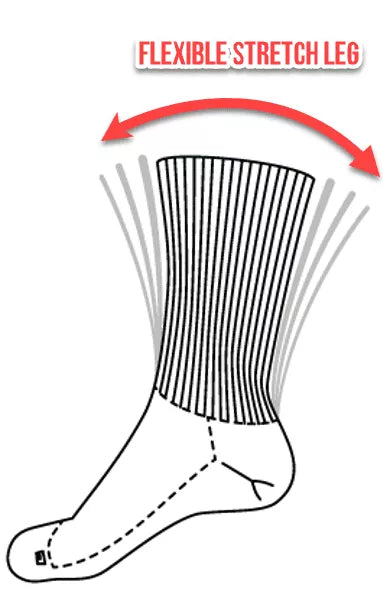
A stretch leg helps to keep your feet healthy and helps to improve blood flow compared to a tighter cuff
Flexible stretch leg
Maintains circulation without constricting the leg and leaving marks. The stretch leg is also highly breathable to help with excess heat removal.
Ergonx diabetic socks have a non-binding cuff aimed at containing swelling while not restricting blood flow to the foot.
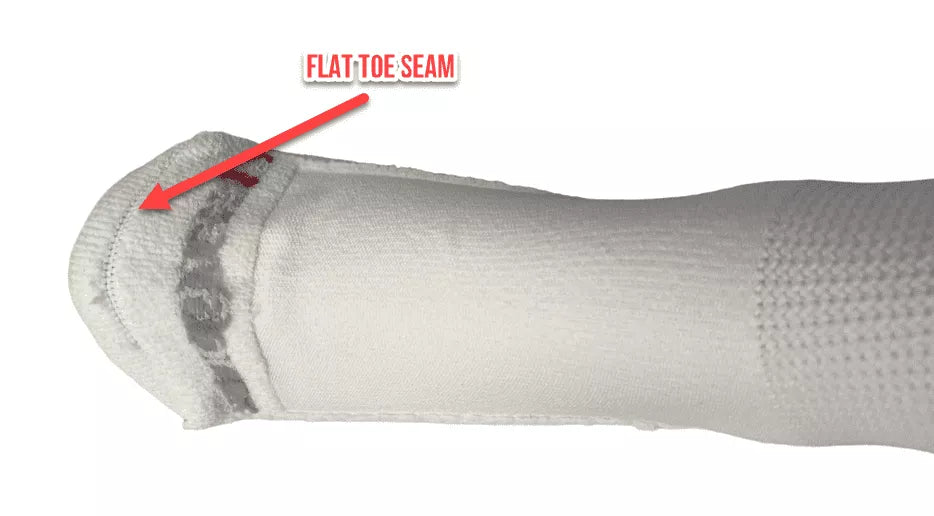
The toe seam on the Ergonx socks helps to reduce irritation.
Seamless toe or Flat toe seam
The seamless toe helps to limit irritation around the toe area. Diabetic complications and amputation often arise due to trauma and injury to the skin and nails. Making our socks with a seamless toe inside reduces the chance of blisters, irritation and infection. Seamless socks are less likely to cause irritation and injury to the foot.
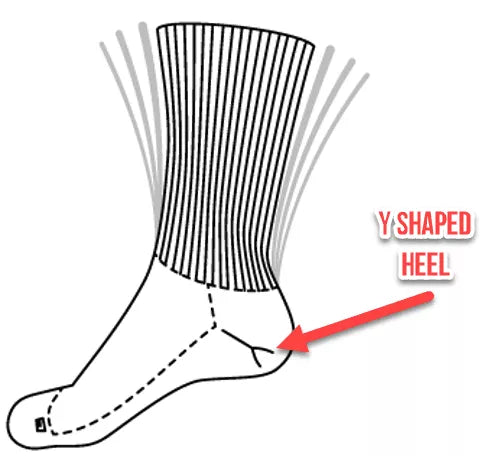
Diabetic crew socks showing a Y shaped heel for a better fit to the foot
The Y Shaped Heel
A Y-shaped heel is beneficial for diabetic patients because it conforms better to the natural shape of the heel, which can reduce irritation and increase comfort. This is important for diabetic patients because they are more susceptible to foot complications such as foot ulcers, infections, and neuropathy. By reducing irritation and discomfort, the risk of these complications can be lowered. Additionally, a Y-shaped heel can provide better support and stability for the foot, which can also help prevent injuries and complications. A well-fitted sock with a Y-shaped heel can be an important factor in maintaining the foot health of diabetic patients.

The best diabetic socks have a breathable upper.
Breathable upper
A breathable upper on a diabetic sock allows air to circulate around the foot, which helps to keep the skin dry and cool. This can reduce the risk of developing moisture-related skin problems such as bacterial infections, fungal infections or blisters.
A well fitted breathable upper can help to reduce pressure on the foot. When a diabetic patient wears socks that are too tight or made from non-breathable materials, this can create pressure points on the foot that can lead to discomfort or even injury. By allowing the foot to breathe, a diabetic sock with a breathable upper can help to alleviate pressure and reduce the risk of developing foot ulcers or other injuries.
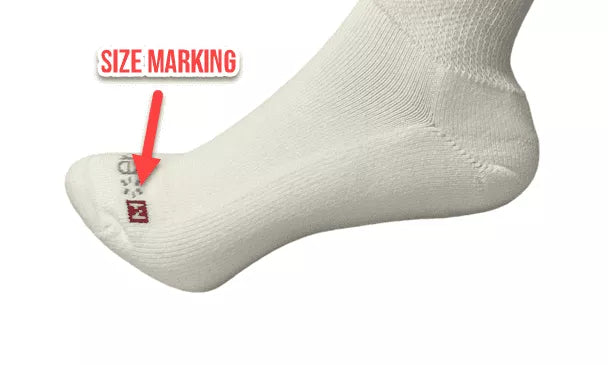
Nerve damage and blood vessel damage in the eyes make it more difficult for a diabetic to match up their socks after the wash.
Size marking – Makes it easy to match up after washing
High blood sugar levels damage the nerves and blood vessels throughout the body. This leads to poor eyesight in diabetics. Diabetic retinopathy is the most common diabetic eye disease and a leading cause of blindness in diabetics.
For easy match-up after washing for customers with diabetic-related eye disease, Ergonx diabetic socks have the size markings clearly labelled on the toe.
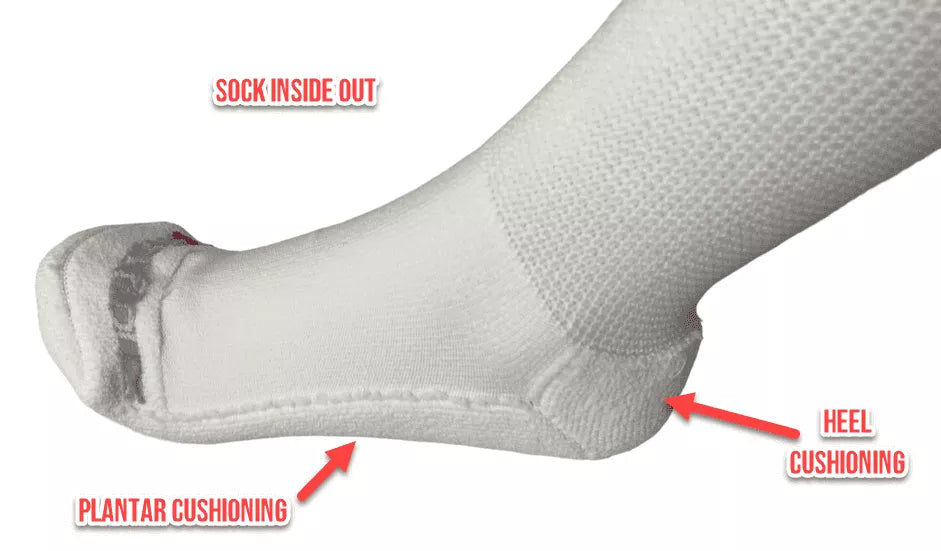
Extra padding and Extra Cushioning is added to the plantar aspect of the Ergonx diabetic socks.
Cushioned Sole and Heel Cushioning
Our diabetic socks use a thin dense cushioned section to improve comfort and decrease pressure. Pressure lesions and damage from pressure are major risk factors for diabetic foot injury.
Any injury to the diabetic foot is a potential portal for infection. Pressure lesions (sores) are a risk factor for diabetics as they are neuro-compromised (they don’t feel well) and vascular-compromised (they will not heal well). Diabetic customers also suffer from limited blood flow to the foot as the disease progresses. The longer the customer has had diabetes the greater the risk of complications from the disease.
Diabetics with sensitive feet and customers with generally sensitive feet will also benefit from the added extra padding to the plantar aspect of the socks as it will reduce the pressure over the bony prominences of the feet.

A non binding leg show here on the Ergonx diabetic crew socks. This helps to maintain blood circulation and reduce swelling
Non-Binding Cuff
Any injury to the diabetic foot is a potential portal for infection. Pressure lesions (sores) are a risk factor for diabetics as they are neuro-compromised (they don’t feel well) and vascular-compromised (they will not heal well). Diabetic customers also suffer from limited blood circulation to the foot as the disease progresses. Ergonx diabetes socks have a non-binding cuff aimed at containing swollen feet and ankles while not restricting blood flow to the foot.
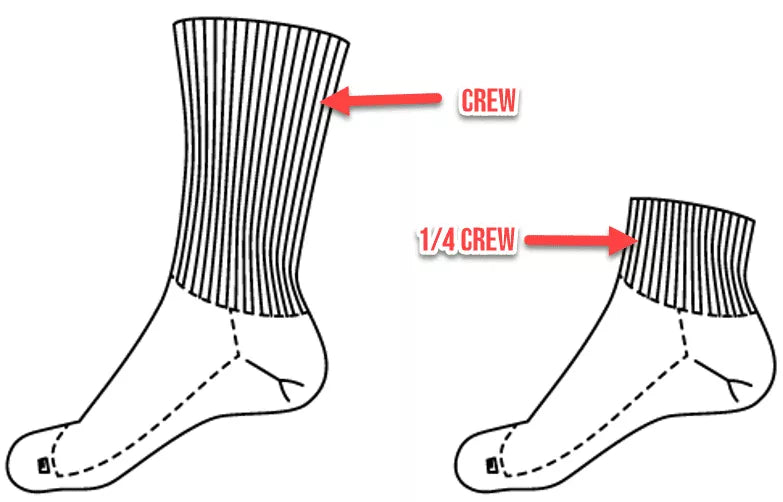
Ergonx Diabetic Socks: Diabetic crew socks and Diabetic Quater Crew Length Socks (Ankle Socks)
Length of sock cuff
The Ergonx socks are perfect for diabetics as they work with our clinical treatments aimed at limiting damage to the diabetic foot. The Ergonx diabetes socks come in 2 lengths, diabetic crew socks and diabetic quarter crew socks (aka ankle socks). As a Podiatrist, I must admit the crew socks are my preferred length as they offer more protection to the lower leg, help to control swelling, help with venous return (blood circulation) and are less likely to slip and cause issues with fit. Crew socks are also the best all-around socks for day-to-day wear.
Moisture Control
The Ergonx sock range helps to use moisture-wicking fabric to move moisture away from the foot to keep the feet dry and limit the chance of blisters. This is achieved by using a combination of natural and synthetic fibers to wick the sweat away from the foot and then hold it away from the foot.
Nylon is a synthetic material that is known for its durability, moisture-wicking fabric properties, and ability to dry quickly. In diabetic socks, nylon helps to wick moisture away from the skin and transfer it to the outer layer of the sock, where it can evaporate more easily. This helps to keep the feet dry and reduces the risk of fungal or bacterial infections.
Cotton is a natural fiber that is soft, breathable, and absorbs moisture well. In diabetic socks, cotton is often blended with synthetic fibers like nylon and Lycra to provide a balance of moisture-wicking properties and softness.
Cotton helps to absorb excess moisture from the skin and release it into the air, which can help to reduce the risk of skin irritation and infections.
Lycra is a synthetic fiber that is known for its stretch and recovery properties. In diabetic socks, Lycra is often used to provide a comfortable and secure fit without constricting the foot or leg. This can help to improve circulation and reduce the risk of pressure points or blisters.
Overall, the combination of nylon, cotton, and Lycra in diabetic socks helps to manage moisture by wicking sweat away from the skin, absorbing excess moisture, keeping the feet dry, and providing a comfortable, non-constricting fit. This can help to reduce the risk of foot complications and promote healthy skin and circulation in people with diabetes.

Silver yarn does not wash out of the Ergonx diabetes socks.
Bacterial Load Control (Silvermesh)
Bacterial skin infections are another risk factor for diabetics. The Ergonx diabetic socks use a yarn containing silver microparticles to limit bacterial growth. Because the silver particles are part of the yarn itself they have a permanent effect and will be effective past 100 washes.
The anti-odor features of silvermesh yarn will also help to keep your smelling fresh for longer.

Ergonx socks size guide. Do your socks have enough sizes to fit your foot correctly?
Enough sizes to actually fit your feet
It is important for diabetic socks to come in enough sizes to fit your feet properly because a snug-fitting sock can reduce the risk of irritation and injury to the foot. It is not often considered that a foot injury can be caused by ill-fitting socks. If the sock is too loose or slips around on the foot, it can cause friction and rubbing that can lead to blisters or other skin injuries. These injuries can be particularly problematic for people with diabetes, as they may have reduced sensation in their feet and be less likely to notice the damage until it becomes more serious.
Properly fitting diabetic socks can also help to reduce the risk of complications such as poor circulation and foot ulcers, which can be serious and difficult to treat. Socks that are too tight will also restrict already poor blood circulation (restrict blood flow) and irritate the feet. By wearing socks that fit well and provide adequate support, people with diabetes can help to maintain the health of their feet and avoid these types of complications.
HOW TO CARE FOR YOUR DIABETIC SOCKS
It is important to care for your diabetic socks properly, especially when they contain silver fibers, nylon, and cotton, by following the care instructions below.
Machine washing and tumble drying on a low heat setting can help to keep the socks clean and fresh, while avoiding bleach and fabric softener can help to preserve the integrity of the materials and prevent damage to the socks.
Silver fibers are often added to diabetic socks because of their antimicrobial properties, which can help to reduce the risk of infection and odor. However, these fibers can be delicate and may require special care to maintain their effectiveness. Similarly, nylon and cotton are common materials used in diabetic socks because of their softness and breathability, but they can be susceptible to damage if washed or dried improperly.
By following the care instructions provided with your diabetic socks, you can help to ensure that they remain clean, comfortable, and effective at providing the support and protection that your feet need. Proper care can also help to prolong the life of your socks and reduce the need for frequent replacements.
-

Care instructions for Ergonx socks
MATERIALS IN THE ERGONX DIABETIC SOCKS - WHAT ARE THE BENEFITS?
Diabetic socks are specifically designed to manage foot moisture and reduce the risk of foot complications for people with diabetes. Moisture-wicking materials such as nylon, cotton, and Lycra are commonly used in diabetic socks because of their moisture-wicking properties, durability, and stretch.
In addition to the above benefits, diabetic socks may also include silver fibers for bacterial control. Silver has been found to have antimicrobial properties and can help to reduce the risk of foot infections. Silver fibers in diabetic socks can also help to reduce odors caused by bacterial growth.
Moisture-wicking properties are important in diabetic socks because excessive moisture can lead to fungal or bacterial infections. Nylon, being a synthetic material, is excellent at moisture-wicking and quick-drying. Cotton, on the other hand, is a natural fiber that is soft, breathable, and has good moisture absorption properties. Lycra provides stretch and recovery properties for a comfortable and non-constrictive fit.
The cushioning provided by these materials is also essential for pressure lesion prevention, reducing pressure and friction on sensitive areas of the foot. Nylon provides durable cushioning, while cotton is gentle on the skin and provides comfort. Lycra provides a comfortable and secure fit without constricting the foot or leg.
Diabetic socks that include materials such as nylon, cotton, and Lycra, as well as silver fibers, can help manage foot moisture, prevent bacterial growth, and reduce the risk of foot complications for people with diabetes. The cushioning provided by these materials is also important for pressure lesion prevention. It is crucial for people with diabetes to choose diabetic socks that provide adequate cushioning.
-

What are Ergonx socks made from?Socks for diabetes composition.
DIABETIC SOCKS VS. COMPRESSION SOCKS - IS THERE A DIFFERENCE
Diabetic socks are designed to provide protection, slight compression, cushioning, and bacterial control for people with diabetes who are at risk of developing foot complications due to poor circulation and nerve damage (diabetic neuropathy). They are typically made from soft, breathable materials that reduce irritation and friction on the skin. They also have non-binding cuffs to prevent constriction and mild compression to promote blood flow.
Compression socks, on the other hand, are a more medical-grade compression, and are primarily designed for people who experience swelling, aching, or other symptoms related to poor blood flow in the legs or feet. They often provide graduated compression, which means they exert the greatest pressure at the ankle and gradually decrease pressure up the leg. This helps to promote circulation and reduce swelling and discomfort.
While diabetic socks may also provide some degree of compression, their primary function is to protect and cushion the feet, prevent infections, and promote blood flow.
Compression socks, on the other hand, are designed specifically for compression and swelling relief. However, people with diabetes who experience swelling or poor circulation in their feet may benefit from wearing compression socks in addition to diabetic socks, under the guidance of a healthcare professional.
HOW WE SELECTED THE FEATURES OF THE BEST DIABETIC SOCKS
After treating diabetic patients for over 20 years we have seen almost every style of diabetic sock some through the clinic. So over many years we have designed and developed what we believe is the perfect sock for day-to-day wear for a diabetic patient.
We know you will find our diabetic socks comfortable and beneficial to your foot health.

About the Author
Kent Elliot (Podiatrist). B App. Sc. Pod (Hons), B.Sc(HMS). M.A. Pod. A
Kent graduated from the University of Queensland with a Bachelor of Science (majoring in Human Movement Studies) and from Podiatry at The Queensland University of Technology (QUT). During this time Kent took a special interest in exercise and conditioning training, orthotics, and plantar fasciitis. Kent has a personal interest in and has participated in many sports including rugby, athletics, boxing, tennis, and running.

